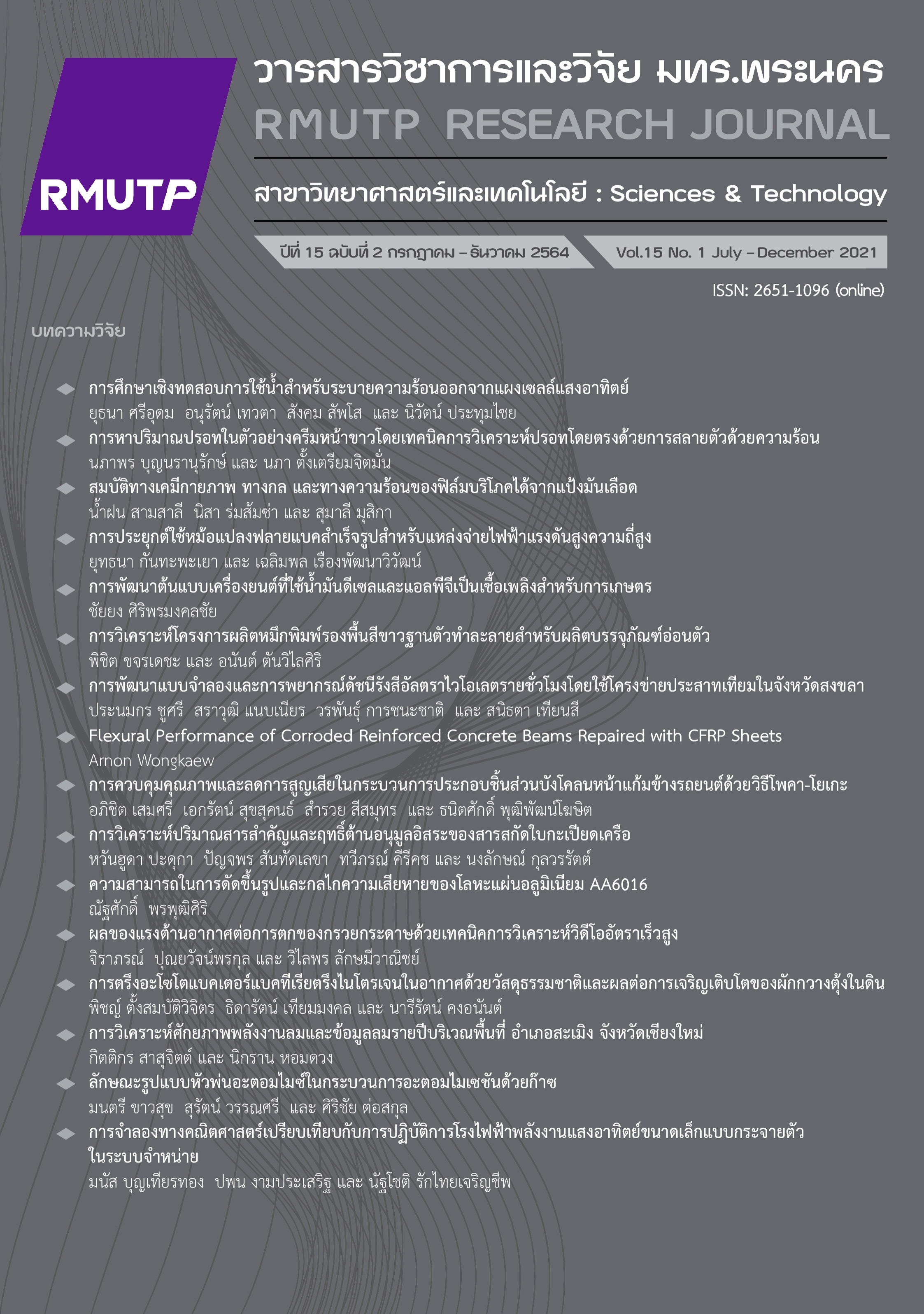Determination of Mercury Contents in Facial Whitening Cream Samples by Direct Thermal Decomposition Mercury Analyzer
Main Article Content
Abstract
Direct thermal decomposition mercury analysis is an efficient technique for determination of mercury in facial whitening creams. The analysis can be performed without any sample preparation. The samples can be weighed and placed directly into the analyzer. Thus, there is no chemical waste produced in sample preparation. The time and energy used in sample digestion are saved as well. The calibration curve between mercury absorbance in terms of peak height and weight of standard mercury in the range of 0.1-10 ng was created. The calibration curve was linear followed the equation y=2.003x10-2X– 5.14x10-4 with coefficient of determination (R2) 0.9991. The precision in term of repeatability were 14% and 5.9% rsd (n=3) at 1.2 and 868 µg kg-1, respectively. The recoveries were between 88-110%. The detection limit (LOD) was 0.1 µg kg-1 (3sd/m, n=10). The amount of mercury detected in 12 whitening cream samples sold in Chonburi province during the year 2019 were within the safety standard permitted in general cosmetics under the notification of the Ministry of Public, except two samples were over the permitted standard.
Article Details

This work is licensed under a Creative Commons Attribution-NonCommercial-NoDerivatives 4.0 International License.
ลิขสิทธ์ ของมหาวิทยาลัยเทคโนโลยีราชมงคลพระนครReferences
R. D. Barr, B. A. Woodger and P. H. Rees, “Levels of mercury in urine correlated with the use of skin lightening creams,” The American Journal of Clinical Pathology, vol. 59, pp. 36-40, Feb. 1973.
C. C. Sun, “Allergic contact dermatitis of the face from contact with nickel and ammoniated mercury in spectacle frames and skin-lightening creams,” Contact Dermatitis, vol. 17, pp. 306–309, Jul. 1987.
M. M. Weldon, M. S. Smolinski, A. Maroufi and B. W. Hasty, “Mercury poisoning associated with a Mexican beauty cream,” The Western Journal of Medicine, vol. 173, no. 1, pp. 15-18, Jul. 2000.
T. Y. Chan, “Inorganic mercury poisoning associated with skin-lightening cosmetic products,” Clinical Toxicology, vol. 49, no. 10, pp. 886-891, Sep. 2011.
A. Boonprachom, N. Yukittichai, N. Ekkabut, N. Pongnimitprasert and N. Nuntharatanapong, “Investigation of ammoniated mercury and hydroquinone in whitening creams distributed in amphur muangnakhon pathom province,” Thai Bulletin of Pharmaceutical Sciences, vol. 8, no. 1, pp. 1-8, Jan. 2013.
P. Kongseree. (2015, Mar 27). Mercury Test Kit-Cosmetics, Department of Chemistry Faculty of Science Mahidol University. [Online]. Available:https://old.mahidol.ac
.th/th/latest_news58/DMSc-Award.html
S. S. Agrawal and M. Mazhar, “Adulteration of mercury in skin whitening creams – A nephrotoxic agent,” Current Medicine Research and Practice, vol. 5, pp. 172-175, Aug. 2015.
Y. B. Ho, N. H. Abdullah, H. Hamsan and E. S. S. Tan, “Mercury contamination in facial skin lightening creams and its health risks to user,” Regulatory Toxicology and Pharmacology, vol. 88, pp. 72-76, May 2017.
C. P. Peregrino, M. V. Moreno, S. V. Miranda, A. D. Rubio and L. O. Leal, “Mercury Levels in Locally Manufactured Mexican Skin-Lightening Creams,” International Journal of Environmental Research and Public Health, vol. 8, no. 6, pp. 2516-2523, Jun. 2011.
S. S. Agrawal and P. Sharma, “Current status of mercury level in skin whitening creams,” Current Medicine Research and Practice, vol. 7, no. 2, pp. 47-50, Apr. 2017.
S. Y. Ng, F. Dewi, J. Wang, L. P. Sim, R. Y. C. Shin, and T. K. Lee, “Development of a cosmetic cream certified reference material: Certification of lead, mercury and arsenic mass fractions in cosmetic cream,” International Journal of Mass Spectrometry, vol. 389, pp. 59-65, Oct. 2015.
J. V. Cizdziel and S. Gerstenberger, “Determination of total mercury in human hair and animal fur by combustion atomic absorption spectrometry,” Talanta, vol. 64, pp. 918-921, Jun. 2004.
D. Saniewsk and M. Bełdowska, “Mercury fractionation in soil and sediment samples using thermo-desorption method,” Talanta, vol. 168, pp. 152–161, Mar. 2017.
A. Luippold and M. S. Gustin, “Mercury concentrations in wet and dry cat and dog food,” Animal Feed Science and Technology, vol. 222, pp. 190–193, Oct. 2016.
L. Makedonski, K. Peycheva and M. Stancheva, "Determination of heavy metals in selected black sea fish species,” Food Control, vol. 72, pp. 313-318, Aug. 2017.
F. Jalilehvand, B. O. Leung, M. Izadifard and E. Damian, “Mercury(II) Cysteine Complexes in Alkaline Aqueous Solution,” Inorganic Chemistry, vol. 45, no. 1, pp. 66-73, Jan. 2006.
G. D. Long and J. D. Winefordner, “Limit of detection, A closer look at the IUPAC definition,” Analytical Chemistry, vol. 55, no. 7, pp. 712A-724A, Jun. 1983.
AOAC, "Guidelines for standard method performance requirements: Appendix F," Arlington, VA, 2012, pp. 9.
C. R. Hamann et al., “Spectrometric analysis of mercury content in 549 skin-lightening products: Is mercury toxicity a hidden global health hazard?,” Journal of the American Academy of Dermatology, vol. 70, no. 2, pp. 281-287, Feb. 2014.


